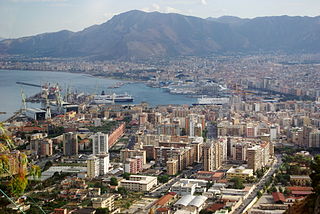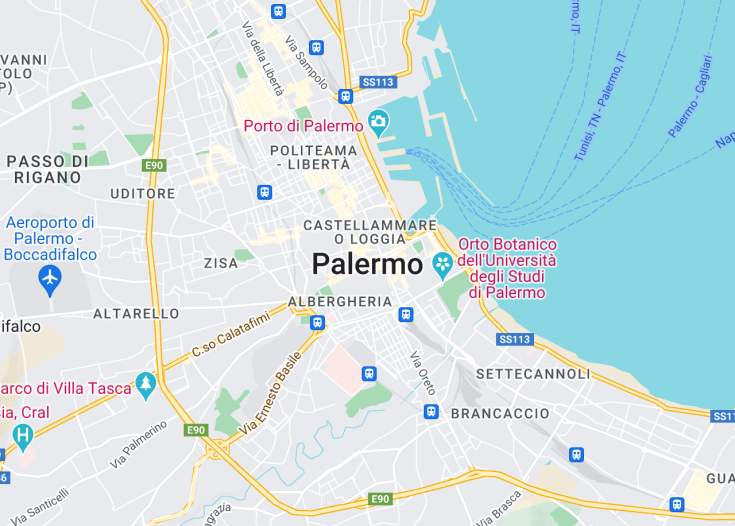Palermo, the capital of Sicily, is a city steeped in history and culture, offering a blend of architectural wonders and a vibrant street life. Founded by the Phoenicians, the city flourished under Arab rule, becoming a melting pot of civilizations. Visitors can explore stunning sites like the Palermo Cathedral, the Norman Palace, and the ancient Capuchin Catacombs. With its bustling markets, such as the famous Ballarò and Vucciria, and refined gastronomy influenced by diverse cultures, Palermo promises a rich, sensory journey through time and taste.
Avoid visiting during the peak summer months if you prefer a less crowded experience and milder temperatures. Early spring and late autumn are ideal for enjoying Palermo’s charm.
To truly experience the local culture, engage with Palermo’s street food scene, featuring delights such as panelle and arancini, which encapsulate the city’s rich culinary heritage.
Top things to do & see in Palermo
Select the following sights and activities to discover best tickets and tours available in Palermo.
Palermo: The Heartbeat of Sicily
| Country | Italy |
| Time in Palermo | GMT+2 |
| Language spoken | Italian |
| Population | 865,000 (According to 2022 estimates) |
| Currency | Euro (€, EUR) |
| Airports |
|
Palermo is not only the capital of Sicily but also a vibrant historical hub whose history stretches back more than 2,700 years. As a melting pot of various cultures through the ages, including the Phoenicians, Romans, Byzantine Greeks, Arabs, Normans, and Spaniards, Palermo offers a unique cultural tapestry that’s evident in its architecture, language, and cuisine. It is strategically located in the northern part of the island and boasts an impressive landscape from mountains to beaches, enriching its diverse urban life.
Where is Palermo?
Palermo is nestled on the northwestern coast of Sicily, Italy, offering a stunning view of the Tyrrhenian Sea.
Distances:
| Route | Distance by car | Time by car |
|---|---|---|
| Rome to Palermo | 697 km | Approx. 11 hours |
| Naples to Palermo | 500 km | Approx. 9 hours |
| Milan to Palermo | 1,384 km | Approx. 20 hours |
What is Palermo famous for?
Palermo is renowned for its rich history, stunning architecture, and vibrant street markets. Landmarks like the magnificent Palermo Cathedral and the eerie Capuchin Catacombs offer a glimpse into its diverse past and present.
History
Prehistoric Times to 8th Century BC
Palermo, the capital of Sicily, has been a crossroad of civilization due to its strategic location in the Mediterranean. Evidence of human settlement in the region dates back to the Mesolithic Age (approximately 10,000 BC), with the first known inhabitants being the Sicani, a tribe with likely Iberian origins. These early settlers were later joined by the Elymians and the Sicels, adding to the cultural complexity of the area.
8th Century BC to 3rd Century AD: Greek and Roman Dominance
The city of Palermo was founded by the Phoenicians under the name “Ziz” (flower), and later renamed “Panormus” meaning ‘All Port’ by the Greeks, who took control around the 8th century BC. Panormus flourished under Roman rule after the First Punic War in the 3rd century BC, serving as a key naval base and enjoying economic prosperity. Significant Roman architectural remnants testify to this period.
9th to 12th Century: Arab and Norman Periods
Palermo encountered a major shift in culture and demographics when it was conquered by the Arabs in 831 AD. They transformed the city into a flourishing cultural and economic center, introducing advanced agricultural practices such as the citrus grove systems, and establishing Palermo as an intellectual hub. In 1072, the Normans captured Palermo, and it became the capital of the Kingdom of Sicily. The Normans enhanced its architectural heritage by constructing monumental buildings like the Palermo Cathedral and the Royal Palace.
13th Century to Unification of Italy: A Time of Turmoil
After the Norman domination, Palermo endured a period of chaos marked by frequent changes in rule, from the Hohenstaufen dynasty to the Angevin and the Aragonese. The city’s status fluctuated drastically, impacting its economic and cultural prominence. It wasn’t until the unification of Italy in 1861 that Palermo began to regain its importance, growing rapidly during the industrial expansion in the late 19th and early 20th centuries.
20th Century to Present
Throughout the 20th century, Palermo faced challenges such as Mafia influence and economic disparity, but also experienced significant urban and cultural developments. Recent initiatives to diminish the Mafia’s influence have fostered a safer environment, boosting the city’s tourism and cultural sectors. Today, Palermo is recognized for its rich history, diverse architecture, and vibrant street life, making it a compelling chronicle of survival and resilience through the ages.
Visit Palermo
What to see and do in Palermo
Explore the enchanting city of Palermo and immerse yourself in its rich tapestry of history and culture. Start your journey at the grand Palermo Cathedral, a stunning example of Norman, Moorish, Gothic, and Baroque architecture. Step inside the Palazzo dei Normanni, one of the oldest royal palaces in Europe, and marvel at the glittering mosaics of the Palatine Chapel. Wander through the bustling markets like Ballarò and Vucciria, where the vibrant sights and sounds encapsulate Sicilian life. Don’t forget to visit the Teatro Massimo, Italy’s largest opera house, for a touch of elegance. Art lovers will appreciate the regional archaeological museum, which houses extensive collections that narrate Sicily’s rich history.
Festivals and Events in Palermo
Palermo hosts a variety of cultural events throughout the year that celebrate its rich heritage and lively traditions. Notable among them is the Feast of Santa Rosalia, held in July, which includes a grand procession and fireworks to honor the city’s patron saint. Autumn brings the Kals’Art festival, a vibrant celebration of arts and music spanning several weeks. Additionally, the city vibrates with life during the Holy Week before Easter, featuring ancient rituals and processions that are a spectacle to witness.
Best time to visit Palermo
The ideal time to visit Palermo is during spring (April to June) or autumn (September to November). These months feature pleasant weather, fewer crowds, and a full schedule of cultural events, allowing visitors to fully enjoy the city’s outdoor and historical attractions.
Is Palermo worth visiting?
Palermo is undoubtedly worth visiting for those who appreciate a city with a layered historical narrative and vibrant cultural scene. The city offers a unique blend of architectural styles, historic sites, lively markets, and rich gastronomy, all of which are set against the backdrop of the stunning Sicilian landscape. Whether you are an art lover, history enthusiast, or simply a traveler seeking new experiences, Palermo promises a fulfilling adventure.









